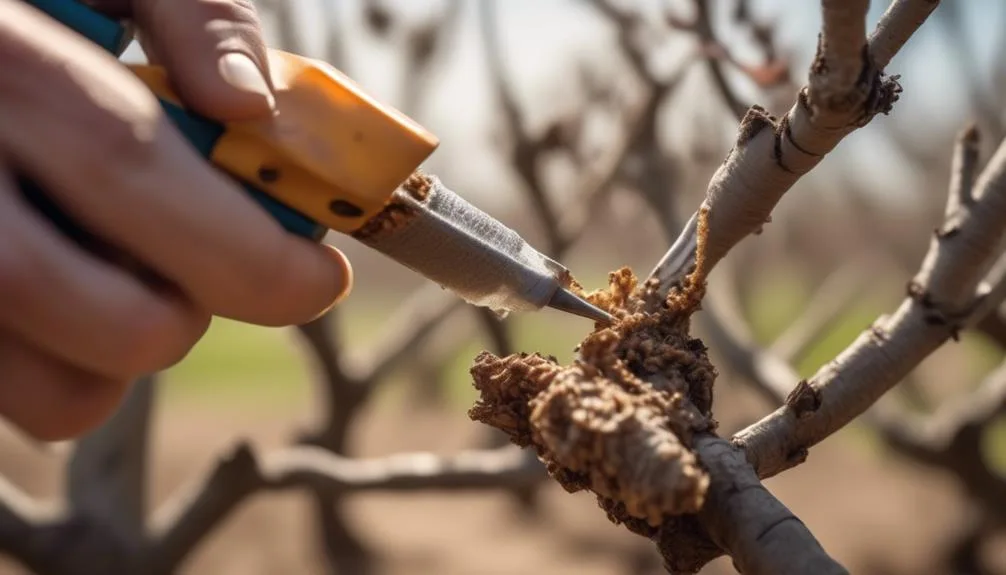Are you curious about grafting almond trees? Grafting almond trees is an ancient practice that allows for the cultivation of unique almond tree varieties.
But can almond trees really be grafted successfully? There's a lot to consider, from compatibility and techniques to timing and success rates.
Whether you're an experienced gardener or just starting out, understanding the ins and outs of grafting almond trees can open up a world of possibilities for your orchard.
Key Takeaways
- Compatibility between rootstock and scion is crucial for successful growth and production in almond tree grafting.
- Proper rootstock selection determines the overall health, vigor, and disease resistance of the tree.
- Grafting onto compatible rootstocks enhances adaptability to different soil conditions and climates.
- Timing and conditions, such as grafting during late winter or early spring and using disease-free rootstock, are important for successful almond tree grafting.
Compatibility of Almond Tree Grafting
When grafting almond trees, ensuring the compatibility of the rootstock and scion is crucial for successful growth and production. The rootstock, typically derived from peach or other almond tree varieties, plays a vital role in determining the overall health and vigor of the tree. Compatibility between the rootstock and scion is essential to promote successful grafting.
Additionally, selecting rootstocks with disease resistance can aid in safeguarding the tree against common almond tree ailments. Grafting almond tree varieties onto compatible rootstocks can also enhance the tree's ability to adapt to different soil conditions and climates, ultimately leading to improved yields.
It's important to carefully consider the compatibility of the rootstock and scion, as it directly impacts the tree's long-term health and productivity.
Grafting Techniques for Almond Trees
To achieve successful grafting of almond trees, mastering the proper techniques is essential for ensuring optimal growth and production. When grafting almond trees, it's crucial to employ the right budding techniques to ensure a successful union between the scion and the rootstock. Additionally, proper rootstock selection is vital for the overall health and productivity of the grafted tree. Here are three essential techniques for grafting almond trees:
- Budding Techniques:
Mastering the art of T-budding or chip budding is crucial for ensuring a successful graft. Understanding the timing and proper execution of budding techniques is essential for the graft's success.
- Rootstock Selection:
Careful consideration of the rootstock is crucial for the tree's overall health and productivity. Selecting a rootstock that's compatible with the scion and provides the desired characteristics is key to successful grafting.
- Technique Precision:
Ensuring that the grafting cuts are clean, precise, and properly aligned is essential for successful grafting. Precision in technique can significantly impact the success of the graft.
Best Time for Grafting Almond Trees
Mastering the proper grafting techniques for almond trees leads us to the critical consideration of the best time for grafting. The optimal conditions and timing considerations play a crucial role in the success of the grafting process.
| Optimal Conditions | Timing Considerations |
|---|---|
| Warm, dry weather | Late winter or early spring |
| Disease-free rootstock | Before bud break |
| Active growth period | Dormant season |
| Adequate moisture levels | After the last frost |
To achieve successful grafting, it's essential to conduct the process during late winter or early spring, just before the almond tree's bud break. This timing allows the graft to heal and integrate with the rootstock before the tree enters its active growth period. Moreover, ensuring optimal conditions such as warm, dry weather and disease-free rootstock, along with adequate moisture levels, is crucial for the successful grafting of almond trees.
Almond Tree Grafting Success Rate
Achieving a high success rate in grafting almond trees requires precise technique and careful attention to key factors like grafting method and tree health.
Here are three crucial factors influencing the success rate of almond tree grafting:
- Grafting challenges: Almond tree grafting can be challenging due to factors such as compatibility between rootstock and scion, proper alignment of cambium layers, and preventing infections.
- Grafting benefits: Successful grafting can result in benefits such as faster fruit production, improved disease resistance, and the ability to grow multiple varieties on the same tree.
- Tree health: The overall health and vigor of the almond tree significantly impact the success rate of grafting. Healthy, well-nourished trees are more likely to accept grafts successfully, leading to higher success rates.
Tips for Grafting Almond Trees
When grafting almond trees, it's essential to carefully select the right rootstock and scion for optimal compatibility and successful integration. Rootstock selection plays a crucial role in determining the tree's overall health, productivity, and resistance to environmental conditions. It's important to choose a rootstock that's well-adapted to the specific soil and climate conditions of your area.
Additionally, selecting a scion with desirable traits such as disease resistance, high yield, and quality nut production is equally important for successful grafting.
When it comes to grafting tools, using sharp and sterile cutting tools is vital to ensure clean cuts and promote successful healing of the graft union. Proper care and attention to detail during the selection process and use of grafting tools will greatly increase the likelihood of a successful almond tree graft.
Conclusion
In mastering the art of almond tree grafting, you can create unique almond varieties through proper techniques and timing. By ensuring compatibility between the rootstock and scion, using the right grafting methods, and choosing the ideal time for grafting, you can increase the success rate of your grafting endeavors.
With care and attention, you can enjoy the rewards of growing your own distinct almond trees.
Happy grafting!

